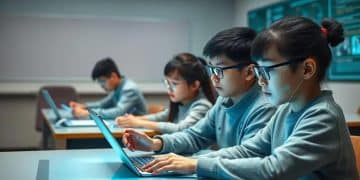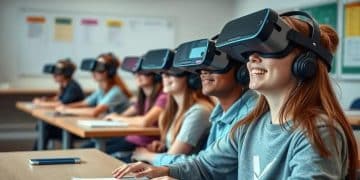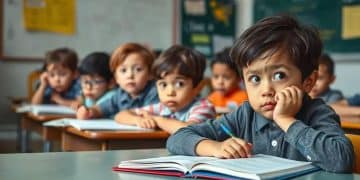Which country has the best education in the world?
Anúncios
The best education in the world is characterized by innovative teaching methods, strong technology integration, inclusivity, and a focus on lifelong learning, preparing students for future challenges in a rapidly evolving global landscape.
Which country has the best education in the world? It’s a question many ask, and the answer can reveal surprising insights about educational systems globally. Join us as we explore the nations leading the way in education, uncovering what makes them exceptional.
Current global education rankings
Understanding the current global education rankings is essential for identifying which countries excel in education. Various organizations rank countries based on different criteria, including student performance, teacher quality, and educational resources.
Top Education Ranking Systems
Several reputable organizations publish annual reports on global education rankings. These reports analyze data from various countries to create comprehensive lists. Some key ranking systems include:
-
🌍 PISA (Programme for International Student Assessment)
-
🏫 THE (Times Higher Education) Rankings
-
🎓 QS World University Rankings
Each of these systems has its criteria, focusing on different aspects of education. For instance, PISA evaluates the skills of 15-year-olds in reading, mathematics, and science. On the other hand, THE considers universities’ performance in teaching, research, and international outlook.
Notable Top Performers
Countries like Finland, Singapore, and Canada consistently rank high in education. Finland is often praised for its holistic approach, reducing testing and focusing on student well-being. Singapore excels due to its rigorous curriculum and emphasis on math and science. Canada thrives on inclusivity and multiculturalism in its education systems.
Additionally, emerging countries, like Estonia and Vietnam, are also making strides in education. Estonia’s focus on digital education and personalized learning is setting new standards, while Vietnam’s commitment to education reform is yielding significant improvements.
Key factors in educational success

Understanding the key factors in educational success is vital for improving learning outcomes worldwide. Various elements play significant roles in creating effective educational systems. By focusing on these aspects, countries can enhance their educational frameworks.
Quality of Teachers
A highly skilled teacher can make a substantial difference in student performance and engagement. Countries that invest in teacher training and mentorship often see better student outcomes. Effective teachers not only deliver curriculum but also inspire and motivate learners.
- Continuous professional development
- Supportive teaching environments
- Clear performance assessments
When teachers are valued and supported, they can cultivate a positive learning atmosphere. This encouragement leads to improved student-teacher relationships and increased student achievement.
Curriculum Relevance
The curriculum must be relevant and adaptable to the needs of students. Successful educational systems ensure that lessons are engaging and connected to real-life experiences. When students see the value in what they’re learning, they are more likely to invest effort in their studies.
Additionally, integrating technology into education can enhance learning experiences. Technology fosters collaboration and creativity, preparing students for future challenges.
Another factor is parental involvement. When parents engage with their children’s education, it fosters a supportive home environment. This involvement can motivate students and help them stay focused on their studies.
Funding and Resources
Adequate funding is essential for maintaining quality education. Schools need resources like modern facilities, learning materials, and extracurricular programs. Countries that prioritize educational funding can create environments conducive to learning.
Moreover, access to technology and infrastructure can bridge gaps in education. Investing in these resources not only benefits students but also the community at large.
Impact of culture on education
The impact of culture on education is profound and shapes how students learn and engage in school. Every culture has its unique perspectives, values, and traditions that influence educational systems and practices. Understanding these cultural dynamics can help improve educational outcomes.
Cultural Values and Learning Styles
Different cultures prioritize various learning styles. For example, cultures that emphasize community often promote collaborative learning. In contrast, more individualistic cultures may focus on personal achievement. Recognizing these differences can help educators tailor their approaches to meet diverse student needs.
-
🤝 Group collaboration vs. individual projects
-
🧠 Apart from rote learning, critical thinking and creativity
-
🌎 Cultural relevance in curriculum design
Schools that incorporate cultural perspectives into the curriculum can foster a more inclusive environment. This strategy not only validates students’ backgrounds but also enhances their overall learning experiences.
Parental Involvement and Community
Another critical aspect is the role of parents and the community in education. In some cultures, parental involvement is a strong indicator of student success. Parents who take part in school activities can support their children’s education positively. Communities also play a pivotal role by providing resources and fostering partnerships.
Engaging parents helps reinforce the value of education at home. Furthermore, having community support can make education more accessible and relevant to students. This collaboration between schools and communities nurtures a healthy educational environment.
Barriers to Education
Cultural differences can also present challenges. In some cases, certain groups may face barriers due to economic, social, or political factors. Discrimination can hinder access to quality education for minority groups. Educators must be aware of these barriers and work to address them.
For example, language barriers may affect student participation in class. Schools that offer bilingual education can help bridge this gap, promoting a more equitable learning experience for all.
Innovation in teaching and learning
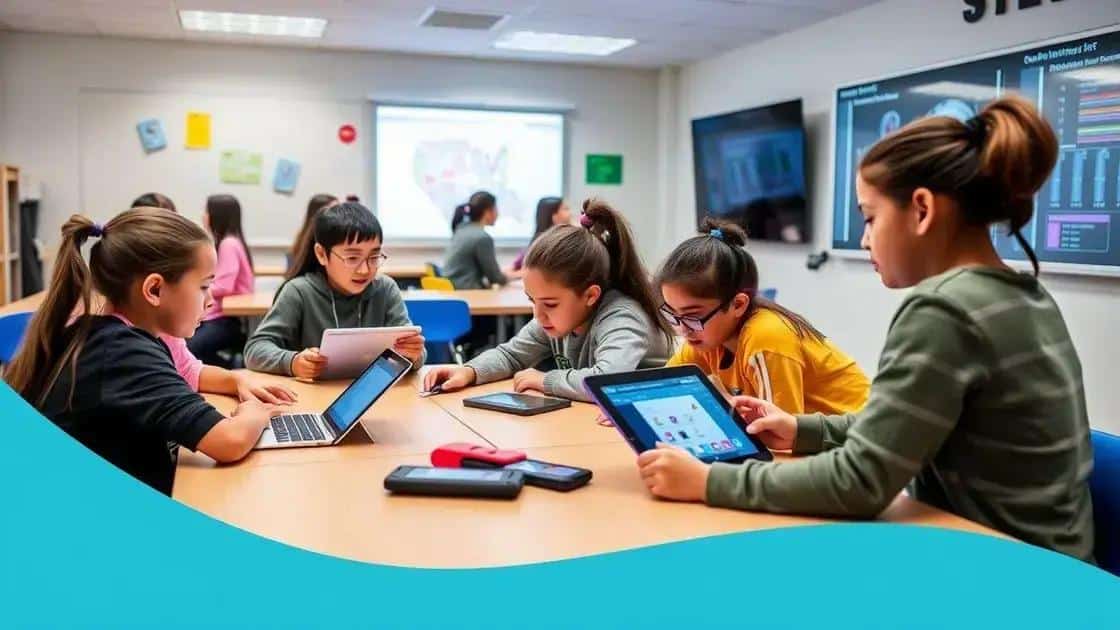
Innovation in teaching and learning is essential to adapt to changing educational needs. New teaching methods and technologies are transforming classrooms around the world. These innovations aim to enhance student engagement and improve learning outcomes.
Technology Integration
Integrating technology into the classroom is one major aspect of educational innovation. Interactive tools, such as smartboards and tablets, create a dynamic learning environment. Students can access resources easily and collaborate more effectively with peers, fostering a sense of teamwork.
- Using educational apps to reinforce learning
- Flipped classrooms for active engagement
- Online resources for diverse learning styles
These tools not only motivate students but also provide teachers with valuable insights into student progress. The use of data analytics can inform teachers of areas where students excel or struggle, allowing for tailored instructional approaches.
Project-Based Learning
Another innovative approach is project-based learning (PBL). PBL encourages students to work on real-world problems and projects, promoting critical thinking and creativity. This hands-on method helps students apply what they learn in a practical context.
In addition, PBL enhances collaboration among students. They learn to communicate effectively and share responsibilities, preparing them for future teamwork in the workforce. This approach also boosts motivation, as students can see the relevance of their studies.
Social-Emotional Learning (SEL)
Incorporating social-emotional learning (SEL) into the curriculum is increasingly recognized as vital. SEL focuses on developing skills such as empathy, self-regulation, and teamwork. These skills not only help students succeed academically but also navigate social interactions.
Educators are finding that integrating SEL with academic content strengthens the overall educational framework. Students who feel valued and supported are more likely to thrive in their studies, leading to improved performance.
Funding and resources in education
Funding and resources in education play a crucial role in shaping quality learning experiences for students. Without adequate financial support, schools struggle to provide the necessary tools and programs for effective education. Investing in education ensures that students receive the best possible learning opportunities.
Importance of Adequate Funding
Funding is essential for maintaining school facilities, hiring qualified teachers, and providing essential learning materials. Schools with higher funding levels can afford advanced technology and extracurricular programs that enhance student engagement. Conversely, underfunded schools may lack basic resources, negatively impacting student performance.
-
📚 Up-to-date textbooks and learning resources
-
💻 Access to technology like computers and tablets
-
🏫 Maintenance of school buildings and facilities
Studies show that schools with higher budgets tend to have better student outcomes. Educators can focus on teaching rather than managing limited resources, allowing for a more effective learning environment.
Allocation of Resources
Not only is funding important, but how schools allocate resources matters too. Prioritizing areas that significantly impact learning, such as teacher training and student support services, can lead to improved outcomes. Schools should also consider investing in mental health programs and counseling services.
Furthermore, partnerships with local businesses and organizations can provide additional resources and funding. These collaborations can enhance the educational experience and offer students exposure to real-world applications of their studies.
The Impact on Educational Inequality
Educational funding disparities can lead to significant inequalities in educational quality. Students in affluent areas often have access to better resources, while those in low-income areas may attend schools with severe shortages. This gap creates a cycle of disadvantage that affects future opportunities for students.
Addressing these funding issues requires systemic change. Policymakers must evaluate resource distribution and ensure that all schools receive the support they need. By working towards equitable funding, we can provide all students with the chance to succeed.
Future trends in global education
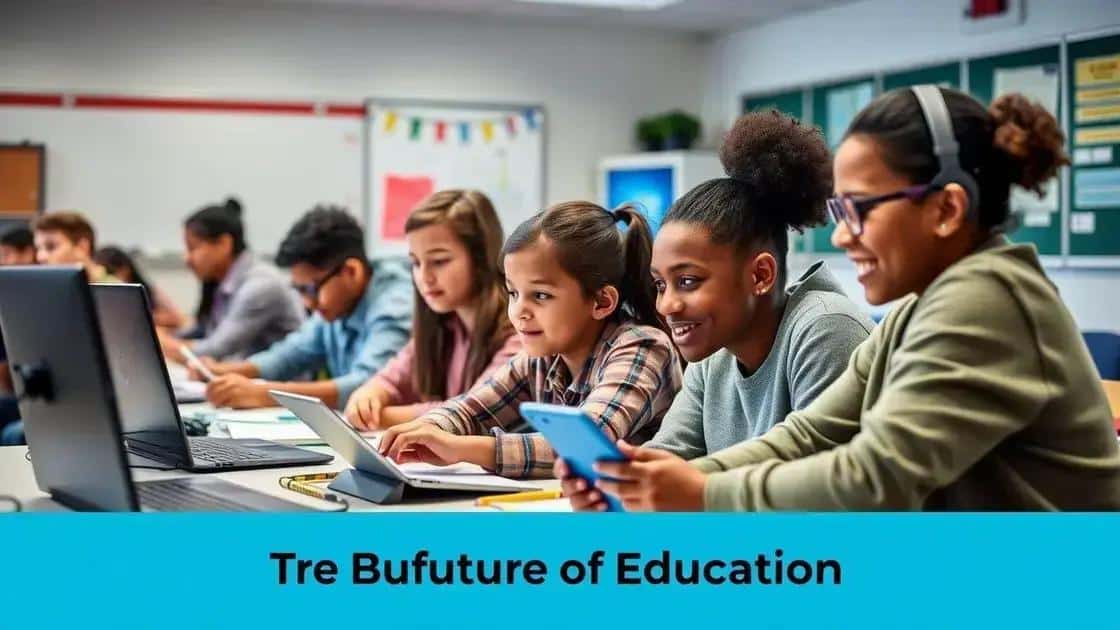
The future trends in global education are shaping how students learn and how educators teach. As the world changes, so do the methods and technologies used in classrooms. Recognizing these trends can help prepare students for success in a rapidly evolving society.
Emphasis on Technology
One significant trend is the continued emphasis on technology. Digital tools are becoming integral to education, allowing for more interactive and personalized learning experiences. Students are using online resources and platforms for research and collaboration, which enhances their learning process.
- Increased use of artificial intelligence
- Growth of online learning and remote education
- Integration of virtual and augmented reality
These advancements make education more accessible, providing opportunities for students worldwide. Technology can also help teachers create engaging lessons and assess student progress more effectively.
Focus on Lifelong Learning
Another emerging trend is the shift towards lifelong learning. As job markets evolve, individuals must continuously adapt and acquire new skills. Education systems are increasingly recognizing the importance of fostering a culture of learning that extends beyond traditional schooling.
Workshops, online courses, and flexible learning options enable adults to pursue new knowledge and skills. This emphasis on lifelong learning supports personal and professional growth, fostering adaptability in a changing world.
Inclusive and Diverse Education
Global education is also moving towards greater inclusivity. Schools are becoming more aware of the importance of cultural diversity and the needs of all students. Inclusive education aims to provide equitable opportunities for every learner, regardless of their background or abilities.
This trend fosters acceptance and understanding among students from various cultures. By promoting diverse perspectives, education can better prepare students to thrive in a global society.
FAQ – Frequently Asked Questions about Global Education Trends
What role does technology play in modern education?
Technology enhances learning experiences, providing digital tools for interactive and personalized education.
How is inclusivity being promoted in education?
Education systems are adopting practices that accommodate diverse learning needs and backgrounds, ensuring equal opportunities for all students.
What is the significance of lifelong learning?
Lifelong learning encourages individuals to continuously acquire new skills, helping them adapt to changing job markets and personal growth.
How are schools preparing students for future challenges?
Schools are focusing on skills like critical thinking, collaboration, and technology use to equip students for success in a rapidly evolving world.

